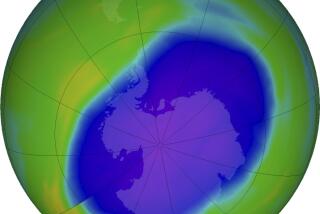Threat to Life on Planet Seen : Air Study Will Examine Damage to Ozone Layer
- Share via
MOUNTAIN VIEW, Calif. — Scientists announced on Friday plans to use a high-flying aircraft for a monthlong experiment to study how chemicals at the Earth’s surface reach the ozone layer, where they present a long-term threat to life on the planet.
The experiment will test a theory about how air is exchanged between the troposphere, the layer of air closest to Earth, and the higher stratosphere, where the ozone damage is occurring, said Philip Russell, project manager for the National Aeronautics and Space Administration.
Scientists believe that man-made chemicals called chlorofluorocarbons, used in refrigerants and in manufacturing, deplete the ozone layer, which shields the Earth from dangerous ultraviolet radiation. More radiation could mean an increase in human skin cancer and destruction of aquatic plants and animals essential to the food chain.
The scientists will use a NASA aircraft called the ER-2, a larger, advanced version of the U-2 spy plane, to carry 16 automated scientific instruments aloft. The instruments will sample air, water vapor and ozone at the tops of giant cumulonimbus thunderclouds along Australia’s northern coast.
The 100 or so researchers who will accompany the ER-2 to Australia will stay on the ground when the plane makes its flights more than 10 miles above the Earth’s surface.
Russell said the ER-2 will leave for Darwin, Australia, on Tuesday and begin its research flights about Jan. 14. Other, lower-flying aircraft from the National Oceanic and Atmospheric Administration and the National Science Foundation will fly experiments in the lower portions of the anvil-shaped thunderclouds and radar networks will be provided by Australia and China.
Analysis of most of the data collected will take years, Russell said.





